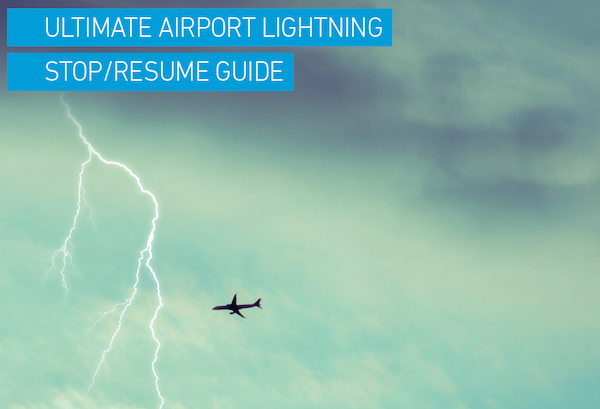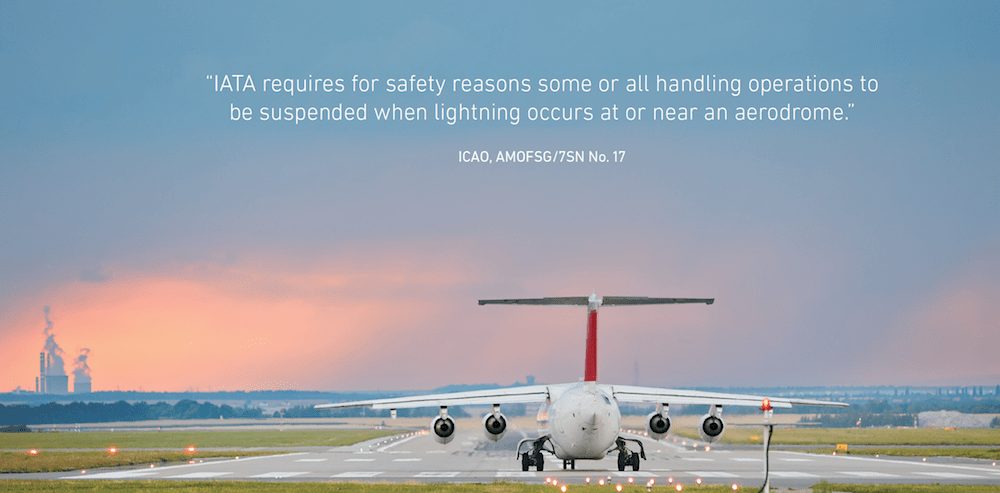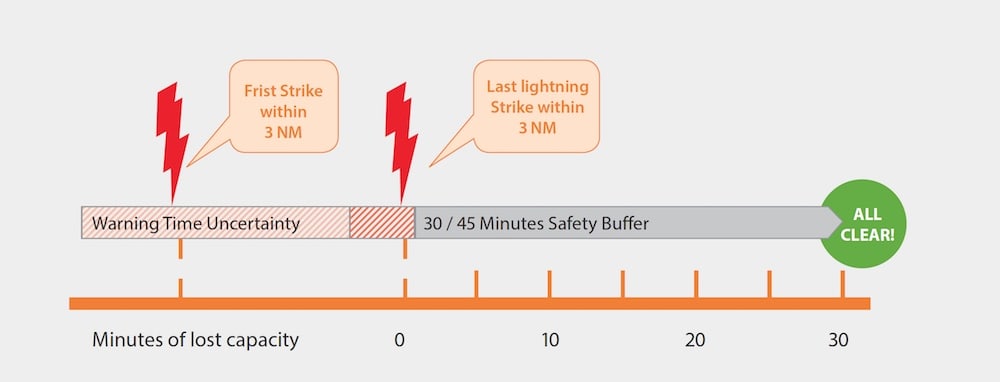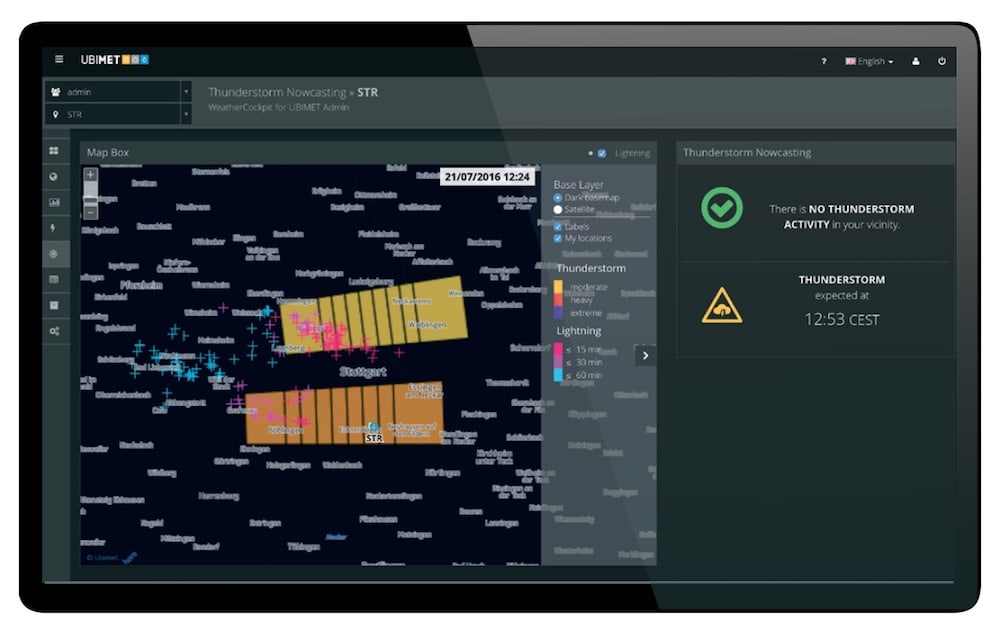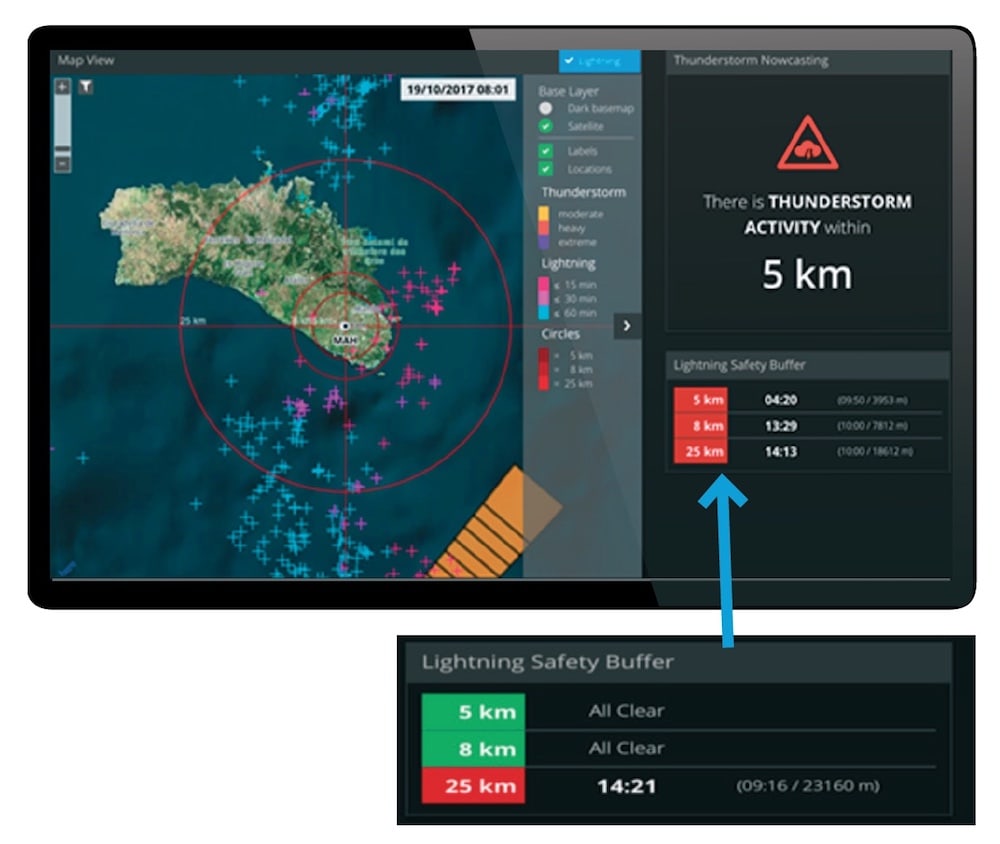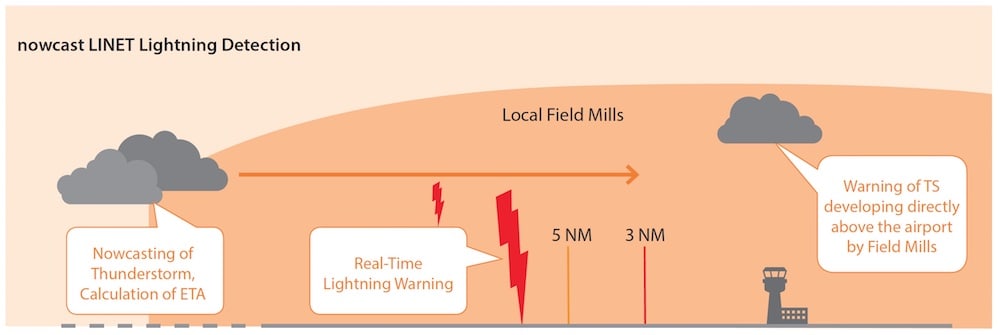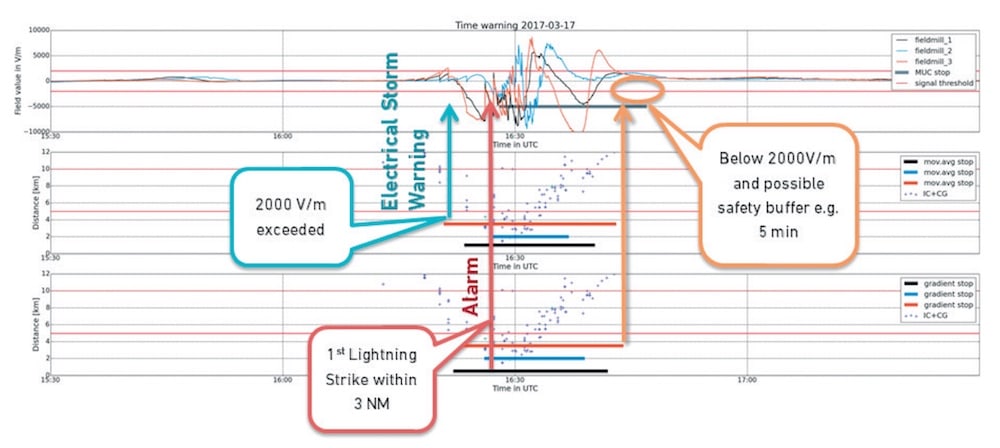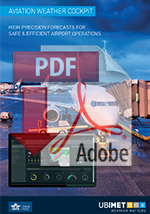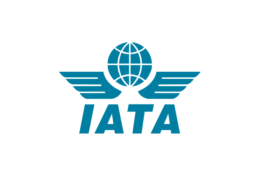How do you stop/resume airfield operations when lightning strikes?
The ULTIMATE airport lightning stop/resume guide for airport operators, ground handlers, airlines and aviation authorities.
Lightning hazard on the apron area
Lightning is a hazardous and occasionally fatal threat to anyone outdoors in the vicinity of lightning activity. This is a major concern for the aviation industry, especially ground handling personnel on the apron area. For safety reasons personnel are directed indoors any time lightning is detected within a critical distance, often 5 nm (9 km). The interruption to outdoor activities performed by apron area will remain until the lightning threat has passed, halting all departure and arrival operations for the whole duration of a thunderstorm.
The aviation thunderstorm challenge
The challenge for aviation operators is to find the optimum balance between personnel safety and operational efficiency. An overly cautious protocol will unnecessarily increase operational inefficiency, delay flights and cause avoidable knock-on impact on airline/airport/handlers schedules. A lax view on lightning may result in injuries, death and damage to hardware.
Global lightning impact areas
Almost all airports in the world are impacted by thunderstorm activity, and thus require a thunderstorm safety procedure. Tropical airports experience thunderstorms throughout the year, whilst airports at higher/lower latitudes experience short and intense thunderstorm seasons.
Thunderstorms: The global threat to Airports
Lightning causes approximately 240,000 casualties globally every year, with 10% being fatally injured.
YouTube: CNN – Airport worker blown off feet by lightning
Hazards beyond lightning
Thunderstorms pose various hazards to aviation operation in addition to dangerous cloud-to-ground lightning. The hazards include:
- Low level windshear
- Poor visibility
- Heavy rainfall
- Hail
- Severe turbulence
- Tornados
WHEN TO STOP GROUND OPERATIONS? WHEN TO RESUME GROUND OPERATIONS?
The current situation loses capacity and put lives at risk!
How do you decide that a thunderstorm is a threat to operations?
A thunderstorm in the vicinity of an airport will stop ground operations, but when is a thunderstorm regarded as in the “vicinity”? How do you decide that a thunderstorm is a threat to operations? Who should decide that? Are they qualified? How much operational pressure are they currently under? These are some of the questions airports, ground handlers and airlines have to answer, without sufficient regulatory support. The suspension and resumption procedures vary from airport to airport and depend on several factors such as lightning detection method and technology, availability of meteorologists, risk parameters and chosen safety buffers. The resulting solutions have been varied and often include a number of the following constraints:
- Ground handling stops based on meteorologist observations are often very conservative and especially re-opening decisions are delayed
- Ground handling stops based on operation personnel observations are accompanied by high inaccuracy and error rate
- Installed lightning detection systems are based on outdated technology or are inaccurate resulting in high error rate and therefore require extended safety time buffers
- No or just inaccurate information available on the estimated occurrence of thunderstorms, duration and end lightning events are processed and communicated manually
- Lightning alarms do not follow a fast and reliable distribution routine
Example of air traffic disruption caused by a thunderstorm in the vicinity of an Airport
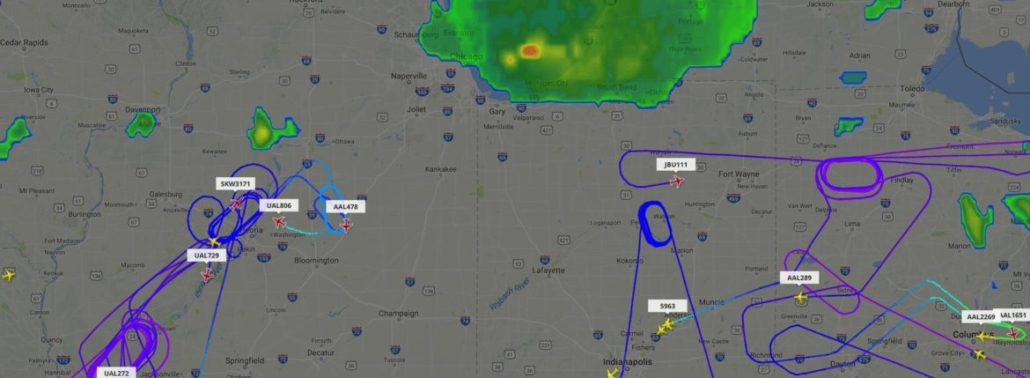
Flights holding or diverting as thunderstorms move through a terminal area
Example: Madrid, 19 April 2016
- 35 minutes without landings
- 36 aircraft diverted
- 3 fuel emergencies
- 1 loss of separation
CAN YOU RELY ON YOUR LIGHTNING DETECTION NETWORK?
The LINET Lightning Detections System
UBIMET relies on the high-precision “LINET” Lightning Detections System. LINET was developed and is operated by the Germany lightning research specialists Nowcast, a subsidiary of UBIMET. LINET is demonstrably one of the most precise lightning-detection systems in the world. So far, there has been no study in which another commercial network has reached the levels of accuracy and reliability offered by LINET. The modern features offered by the LINET network are the key to its superiority and success. These features include:
LINET is demonstrably one of the most precise lightning-detection systems in the world. So far, there has been no study in which another commercial network has reached the levels of accuracy and reliability offered by LINET.
UBIMET & Nowcast The ultimate capacity airside optimization combination
High-precision LINET lightning detection, unparalleled innovations developed in Germany combined with highly precise weather data and ISO certified distributions = the safest & most efficient system throughout the world.
WHAT IS THUNDERSTORM NOWCASTING?
On top of the detecting lightning, UBIMET provides nowcasting for the aviation industry. Nowcasting is the advanced interpellation of data from multiple sources to produce a thunderstorm “track”. The thunderstorm analysis uses LINET lightning data and available radar data in order to identify the location and intensity of thunderstorms. Using a time series of lightning fields, satellite data and/or radar data combined with probabilistic steering fields supported by models, the track and movement speed of each analyzed thunderstorm can be predicted. This enables the prediction of the expected route and speed of thunderstorms cells in the vicinity of the airport. The unique model unlocks the answers to key questions such as: Will a storm cell encroach the aerodrome area? What time will the cell arrive? Does a proactive warning (alert) need to be issued?
Thunderstorm General Unified Storm Alert System
UBIMET crunches the data in global datacenters and applies the proprietary software “GAUSS” (General Unified Storm Alert System) to automatically issue thunderstorm warnings via ISO certified processes. The warnings can be sent via SMS, email, API or push notification and include information on the possible accompanying hazards.
Aviation Weather Cockpit®
The thunderstorm warnings are also visualized in the award-winning “Weather Cockpit®” and are updated frequently, ensuring that the information is always up to date. The intensity of a thunderstorm is represented by different colours: orange (mild), red (moderate) and violet (severe), each with its own set of threshold values.
The threshold values can be adapted to the geographical or climatological region as well as to the user‘s needs.
Overall, the system is able to provide hit rates over 90% for the first 30 minutes along the track. After that, the hit rate decreases as the lead-time exceeds the convective time scale.
Minimize aerodrome stoppages with an automatic lightning safety buffer
A valuable new feature for airport operations was recently developed by UBIMET. The solution helps to minimize ground handling interruptions after thunderstorms and issuing an “all clear” notifications to resume ground handling activities. Based on the high-precision and real-time lightning data from LINET, this new feature shows the “lightning-free” time (e.g. 10 Minute Countdown since the last lightning flash) within the ICAO recommended radiuses of 5 / 8 nm after a thunderstorm. As soon as the countdown (which can be individually tailored to an airport) reaches zero ground handling activities can resume. The safety buffer time can be either defined by national legal requirements or based on the results of an in-depth UBIMET lighting risk study for that airport.
ELECTRICAL FIELD MILL INTEGRATION FOR SUPERIOR AIRPORT SAFETY AND EFFICIENCY
An operations team that utilizes the LINET network, has automated nowcasting GAUSS warnings in place and has implemented a lightning safety buffer based on a UBIMET risk study is very well equipped to manage lightning stoppages. However, the threat still remains of a thunderstorm cell developing directly above the aerodrome area, especially the apron. This threat can be mitigated with the inclusion of electrostatic field mills to the UBIMET system.
Electric field strength directly at the airport
Electrostatic field mills detect local thunderstorm cells above or in the close vicinity of an airport as well as the risk of potential lightning strikes. These sensors measure the electric field strength directly at the airport and therefore measure the potential lightning risk.
If there is no electrical field above a certain area, there is no chance for a lightning strike. Especially thunderstorms that build up over or in close vicinity of an airport always bear the risk that the first lightning strike hits the apron area. Even the best lightning detection system is not able to anticipate this kind of event up front.
Devices to indicate the beginning and the end of ground handling
For airports electrostatic field mills are appropriate devices to indicate the beginning and the end of ground handling stops triggered by lightning activities. This method provides a very accurate, technology-based decision support and allows an immediate resumption of ground-handling activities. The combination of the LINET lightning detection system with electrostatic field mills provides a superior decision basis and the highest safety level for the airport.
Creating a trusted airport thunderstorm decision base tool
Having the most advanced and accurate lightning detection system in the world is a very good start, but the question often remains – what do we do now? How do we make and communicate any decisions? And who makes the decisions?
Information flow issues
Decisions and warnings (alerts) are often made manually either by a phone call, email or manual activation of audio/visual alarms. This process relies on those responsible to take reliable, quick and decisive action based on data from incumbent and outdated lightning detection systems. Due to the high-pressure environment surrounding stopping/restarting ground handling operations, and the poor availability of accurate data, decisions are often conservative, time-intensive and unnecessarily reduce capacity.
The false economy
A modern lightning detection and warning system use an integrated approach, making decisions based on highly precise data and distributing decisions, in real time and to exactly those who need to know. However, not all modern systems are developed equally, some systems still use outdated sensors as a basis for lightning detection. This combination of outdated technology with a modern interface leads to a false economy, producing inaccurate alerts quickly. Other systems use modern detection networks but deliver data-heavy interfaces. These systems are often only usable for highly trained meteorologists and slow down the decision-making process due to information overload.
Integrated decision base tool
The unique and proven UBIMET system is a leading-edge solution. Data is combined in real time from multiple sources, including from the latest lightning detection system “LINET”, electrostatic field mills and weather data from airport specific weather models. UBIMET creates weather insights that form a solid decision base in critical situations. Decisions are then made and distributed via ISO certified distribution channels, within the Weather Cockpit® and according to individually tailored airport specific criteria. The colour-coded nowcasting map was designed with user experience in mind and complex real-time data has been transformed into easily readable information. Furthermore, the intuitive traffic light warning system alerts users to potential danger, via SMS, email, push notification, API and within the Weather Cockpit®.
By combining the latest lightning technology developed in Germany, intuitive product design and proven message distribution channels, UBIMET has raised the bar in aviation lightning detection and warning systems.

